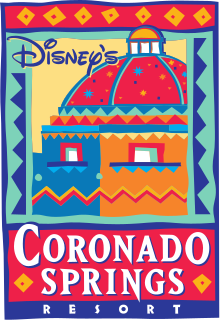
Disney's Coronado Springs Resort is a resort hotel at the Walt Disney World Resort that opened on August 1, 1997. The resort is located in the Animal Kingdom Resort Area. Its theme is American colonial Spanish and southwestern American. This hotel is categorized as a 'moderate' resort. This was Walt Disney World's first attempt at a 'moderate' resort with a convention center. It is the only moderate level Disney resort with suites, a cafeteria-style restaurant, a formal dinner restaurant, a gift shop, an arcade, one large pool, three quiet pools, a salon, fitness center, and a dance club. The resort is owned and operated by Disney Parks, Experiences and Products.

The Driskill, a Romanesque-style building completed in 1886, is the oldest operating hotel in Austin, Texas, United States, and one of the best-known hotels in Texas generally. The Driskill was conceived and built by Col. Jesse Driskill, a cattleman who spent his fortune constructing "the finest hotel south of St. Louis".

The New Yorker, A Wyndham Hotel is a 43-story Art Deco hotel located at 481 Eighth Avenue in the Hell's Kitchen neighborhood of Manhattan, New York City, United States. Opened in 1930, it contains 1,083 rooms and is classified as a mid-priced hotel. The 1-million-square-foot (93,000-square-meter) building offers two restaurants and approximately 33,000 square feet (3,100 m2) of conference space.

The Westin Book Cadillac Detroit is a historic skyscraper hotel in Downtown Detroit, Michigan, within the Washington Boulevard Historic District. Designed in the Neo-Renaissance style, and opened as the Book-Cadillac Hotel in 1924, the 349 ft (106 m), 31-story, 453-room hotel includes 65 exclusive luxury condominiums and penthouses on the top eight floors. It reopened in October 2008, managed by Westin Hotels, after a $200-million restoration.
Martineau Galleries is a proposed mixed-use development for Birmingham, England which was shelved in 2009 but re-approved in 2020. It was to connect the Eastside to the city centre core, a major retail area.

The Roosevelt New Orleans in New Orleans, Louisiana, is a 504-room hotel owned by AVR Realty Company and Dimension Development and managed by Waldorf Astoria Hotels & Resorts. The hotel was originally built by Louis Grunewald, a German immigrant, and opened in 1893 as "The Hotel Grunewald."

The Hilton San Francisco Union Square is a skyscraper hotel located several blocks south-west of Union Square in San Francisco, California. Opened in 1964, the innovative 18-story, 1200-room original building was known as a "motel within a hotel", allowing guests to park directly next to their upper-story rooms. Filling an entire city block, it remains one of the tallest structures representing Brutalist architecture, though it has been extensively altered since its construction. A second 46-story tower was added in 1971, while a third smaller 23-story connecting tower was completed in 1987. Renovated in 2017 and still operated by Hilton, it is currently the largest hotel on the West Coast, with 1,921 rooms.

The Battle House Renaissance Mobile Hotel & Spa, is a historic hotel in Mobile, Alabama. The current structure was built in 1908 as the Battle House Hotel. It is the second hotel by that name to stand in this location, replacing an earlier Battle House built in 1852, which burned down in 1905. It is one of the earliest steel frame structures in Alabama.
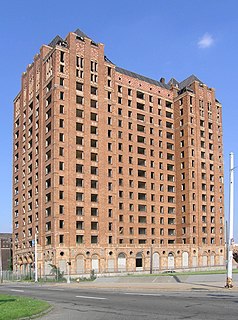
The Lee Plaza is a vacant 16-story high-rise apartment building located at 2240 West Grand Boulevard, about one mile west of New Center along West Grand Boulevard, an area in Detroit, Michigan. It is a registered historic site by the state of Michigan and was added to the United States National Register of Historic Places on November 5, 1981. Designed by Charles Noble and constructed in 1929, it rises to 16 floors and is an excellent example of Art Deco architecture of the 1920s.
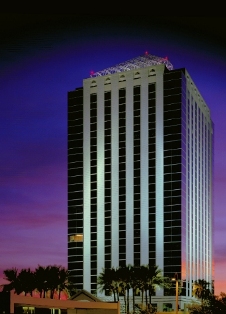
Phoenix City Square, formerly Kent Plaza and the Rosenzweig Center, is a mixed use high rise complex covering 15 acres at 3800-4000 N. Central Ave. in Phoenix, Arizona. The project was developed by the Del Webb Corporation in 1962. The complex features 3 office towers, a hotel, an open-air retail plaza, and a 1200-car parking garage. City Square was designed by the architectural firm of Flatow, Moore, Bryan, and Fairburn. The towers were constructed in 1962, 1964, and 1971. 3800 Tower is 194,482 square feet (18,068.0 m2); 3838 Tower is 236,094 square feet (21,933.9 m2); and 4000 Tower is 295,797 square feet. There is also a large 35,000-square-foot (3,300 m2) Fitness Center, known as Sports Club at City Square, that is part of the complex.
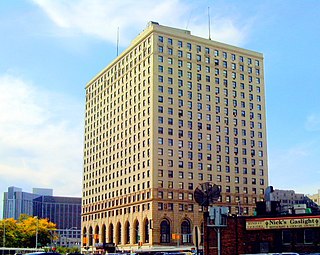
The Detroit-Leland Hotel is a historic hotel located at 400 Bagley Street in Downtown Detroit, Michigan. It is the oldest continuously operating hotel in downtown Detroit, and was listed on the National Register of Historic Places in 2005. The ballroom of the Detroit-Leland has hosted a nightclub, the City Club, since 1983. The hotel is now named The Leland and no longer rents to overnight guests.

The Jefferson–Chalmers Historic Business District is a historic district located on East Jefferson Avenue between Eastlawn Street and Alter Road in Detroit, Michigan. The district is the only continuously intact commercial district remaining along East Jefferson Avenue, and was listed on the National Register of Historic Places in 2004.

The Blackstone Hotel is the tallest hotel in downtown Fort Worth, Texas, at 268 ft (82 m) tall. Located on the corner of Fifth and Main Streets, it is noted for its Art Deco design with terracotta ornamentation and setbacks on the top floors. The hotel was constructed in 1929 and operated for over 50 years before it sat vacant for nearly 20 years. The Blackstone Hotel guest list is full of notable people including Presidents of the United States: Harry S. Truman, Dwight D. Eisenhower, John F. Kennedy, Lyndon B. Johnson, and Richard M. Nixon. The hotel was also host for a few movie stars such as Bob Hope, Clark Gable, and Elvis Presley. It was added to the National Register of Historic Places on February 2, 1984. The building was restored in the late 1990s and is still in use today as the Courtyard Fort Worth Downtown/Blackstone, although it is still known as the "Blackstone Hotel" to those who live in or have ties to Fort Worth.

The ITC Grand Chola is a 5-star luxury hotel in Chennai, India. It is located in Guindy, opposite SPIC building and along the same row of buildings as Ashok Leyland Towers. The building, designed by Singapore-based SRSS Architects, is of mixed-use development with three separate wings and is themed after traditional Tamilian Architecture of the Chola Dynasty. The hotel is the ninth hotel in The Luxury Collection brand. The hotel, built on over 1,600,000 sq ft, is dubbed the largest stand-alone hotel in the country built with an investment of ₹ 12,000 million and has the largest convention centre in the country built on 100,000 sq ft with a 30,000-sq ft pillar-less ballroom. In terms of room inventory, it is the third largest hotel in India with 600 rooms after Renaissance Mumbai Convention Centre Hotel and Grand Hyatt, both in Mumbai.

The Hilton Fort Worth is a historic hotel in downtown Fort Worth, Texas. Constructed from 1920 to 1921 as the Hotel Texas, it was designed by Sanguinet & Staats and Mauran, Russell, & Crowell, with Westlake Construction Co. as the contractor.

The Grand Hotel is a Grade II* listed Victorian five star hotel in the city centre of Birmingham, England. The hotel occupies the greater part of a block bounded by Colmore Row, Church Street, Barwick Street and Livery Street and overlooks St Philip's Cathedral and churchyard. Designed by architect Thomson Plevins, construction began in 1875 and the hotel opened in 1879. Extensions and extensive interior renovations were undertaken by prominent Birmingham architecture firm Martin & Chamberlain from 1890 to 1895. Interior renovations included the building of the Grosvenor Room with Louis XIV style decoration.
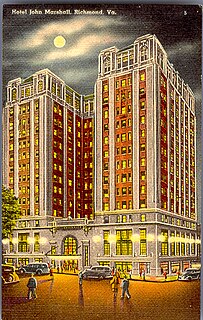
The Hotel John Marshall, first opened in 1929, was one of the leading hospitality establishments in downtown Richmond, Virginia. After the hotel closed in 2004, the building was renovated into upscale residential apartments that opened in December 2011.

Rosewood Washington, D.C. is a luxury boutique hotel located at 1050 31st Street NW in the Georgetown neighborhood of Washington, D.C., in the United States. Originally an office building known as the Canal Building, it was constructed in 1963, and was the first major new building constructed in Georgetown in 50 years. The structure was purchased by two local real estate development companies in 2008 and converted to a hotel. The renovation won multiple awards. The hotel, branded as and managed by Capella Hotels and Resorts, opened in 2013 as the Cappella Hotel. The developers sold the property to Rosewood Hotels & Resorts, which rebranded the hotel as the Rosewood Washington, D.C in 2016.

Palisade Hotel is a heritage-listed pub and hotel located at 35-37 Bettington Street, in the inner city Sydney suburb of Millers Point of New South Wales, Australia, adjacent to Barangaroo Reserve. Administratively, the hotel is in the City of Sydney local government area. It was designed by H. D. Walsh and built in 1915–16. It is privately owned. It was added to the New South Wales State Heritage Register on 2 April 1999.
The Tulsa Club Building is an 11-story structure that stands on the northwest corner of Cincinnati Avenue and East Fifth Street, inside the Oil Capital Historic District of Tulsa, Oklahoma, United States. Designed by Bruce Goff and constructed in 1927 by the architectural firm Rush, Endacott and Rush, it was a joint venture of the Tulsa Club and the Tulsa Chamber of Commerce.



















